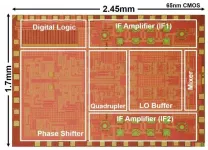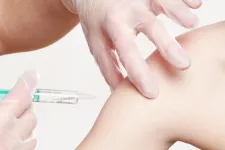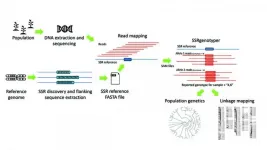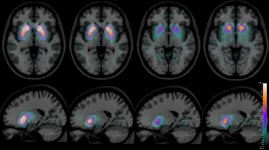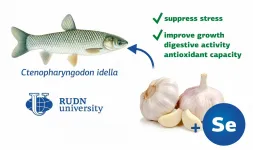(Press-News.org) New research has identified a nanostructure that improves the anode in lithium-ion batteries
Instead of using graphite for the anode, the researchers turned to silicon: a material that stores more charge but is susceptible to fracturing
The team made the silicon anode by depositing silicon atoms on top of metallic nanoparticles
The resulting nanostructure formed arches, increasing the strength and structural integrity of the anode
Electrochemical tests showed the lithium-ion batteries with the improved silicon anodes had a higher charge capacity and longer lifespan
New research conducted by the Okinawa Institute of Science and Technology Graduate University (OIST) has identified a specific building block that improves the anode in lithium-ion batteries. The unique properties of the structure, which was built using nanoparticle technology, are revealed and explained today in Communications Materials.
Powerful, portable and rechargeable, lithium-ion batteries are crucial components of modern technology, found in smartphones, laptops and electric vehicles. In 2019, their potential to revolutionize how we store and consume power in the future, as we move away from fossil fuels, was notably recognized, with the Nobel Prize co-awarded to new OIST Board of Governors member, Dr. Akira Yoshino, for his work developing the lithium-ion battery.
Traditionally, graphite is used for the anode of a lithium-ion battery, but this carbon material has major limitations.
"When a battery is being charged, lithium ions are forced to move from one side of the battery - the cathode - through an electrolyte solution to the other side of the battery - the anode. Then, when a battery is being used, the lithium ions move back into the cathode and an electric current is released from the battery," explained Dr. Marta Haro, a former researcher at OIST and first author of the study. "But in graphite anodes, six atoms of carbon are needed to store one lithium ion, so the energy density of these batteries is low."
With science and industry currently exploring the use of lithium-ion batteries to power electric vehicles and aerospace craft, improving energy density is critical. Researchers are now searching for new materials that can increase the number of lithium ions stored in the anode.
One of the most promising candidates is silicon, which can bind four lithium ions for every one silicon atom.
"Silicon anodes can store ten times as much charge in a given volume than graphite anodes - a whole order of magnitude higher in terms of energy density," said Dr. Haro. "The problem is, as the lithium ions move into the anode, the volume change is huge, up to around 400%, which causes the electrode to fracture and break."
The large volume change also prevents stable formation of a protective layer that lies between the electrolyte and the anode. Every time the battery is charged, this layer therefore must continually reform, using up the limited supply of lithium ions and reducing the lifespan and rechargeability of the battery.
"Our goal was to try and create a more robust anode capable of resisting these stresses, that can absorb as much lithium as possible and ensure as many charge cycles as possible before deteriorating," said Dr. Grammatikopoulos, senior author of the paper. "And the approach we took was to build a structure using nanoparticles."
In a previous paper, published in 2017 in Advanced Science, the now-disbanded OIST Nanoparticles by Design Unit developed a cake-like layered structure, where each layer of silicon was sandwiched between tantalum metal nanoparticles. This improved the structural integrity of the silicon anode, preventing over-swelling.
While experimenting with different thicknesses of the silicon layer to see how it affected the material's elastic properties, the researchers noticed something strange.
"There was a point at a specific thickness of the silicon layer where the elastic properties of the structure completely changed," said Theo Bouloumis, a current PhD student at OIST who was conducting this experiment. "The material became gradually stiffer, but then quickly decreased in stiffness when the thickness of the silicon layer was further increased. We had some ideas, but at the time, we didn't know the fundamental reason behind why this change occurred."
Now, this new paper finally provides an explanation for the sudden spike in stiffness at one critical thickness.
Through microscopy techniques and computer simulations at the atomic level, the researchers showed that as the silicon atoms are deposited onto the layer of nanoparticles, they don't form an even and uniform film. Instead, they form columns in the shape of inverted cones, growing wider and wider as more silicon atoms are deposited. Eventually, the individual silicon columns touch each other, forming a vaulted structure.
"The vaulted structure is strong, just like an arch is strong in civil engineering," said Dr. Grammatikopoulos. "The same concept applies, just on a nanoscale."
Importantly, the increased strength of the structure also coincided with enhanced battery performance. When the scientists carried out electrochemical tests, they found that the lithium-ion battery had an increased charge capacity. The protective layer was also more stable, meaning the battery could withstand more charge cycles.
These improvements are only seen at the precise moment that the columns touch. Before this moment occurs, the individual pillars are wobbly and so cannot provide structural integrity to the anode. And if silicon deposition continues after the columns touch, it creates a porous film with many voids, resulting in a weak, sponge-like behavior.
This reveal of the vaulted structure and how it gains its unique properties not only acts as an important step forward towards the commercialization of silicon anodes in lithium-ion batteries, but also has many other potential applications within material sciences.
"The vaulted structure could be used when materials are needed that are strong and able to withstand various stresses, such as for bio-implants or for storing hydrogen," said Dr. Grammatikopoulos. "The exact type of material you need - stronger or softer, more flexible or less flexible - can be precisely made, simply by changing the thickness of the layer. That's the beauty of nanostructures."
INFORMATION:
USC researchers have developed a new method to counter emergent mutations of the coronavirus and hasten vaccine development to stop the pathogen responsible for killing thousands of people and ruining the economy.
Using artificial intelligence (AI), the research team at the USC Viterbi School of Engineering developed a method to speed the analysis of vaccines and zero in on the best potential preventive medical therapy.
The method is easily adaptable to analyze potential mutations of the virus, ensuring the best possible vaccines are quickly identified -- solutions that give ...
The early prognosis of high-risk older adults for amnestic mild cognitive impairment (aMCI), using noninvasive and sensitive neuromarkers, is key for early prevention of Alzheimer's disease. A recent study, published in the Journal of Alzheimer's Disease, by researchers at the University of Kentucky establishes what they believe is a new way to predict the risk years before a clinical diagnosis. Their work shows that direct measures of brain signatures during mental activity are more sensitive and accurate predictors of memory decline than current standard behavioral testing.
"Many studies have measured electrophysiological rhythms during resting and sleep ...
Scientists at Tokyo Institute of Technology (Tokyo Tech) and NTT Corporation (NTT) develop a novel CMOS-based transceiver for wireless communications at the 300 GHz band, enabling future beyond-5G applications. Their design addresses the challenges of operating CMOS technology at its practical limit and represents the first wideband CMOS phased-array system to operate at such elevated frequencies.
Communication at higher frequencies is a perpetually sought-after goal in electronics because of the greater data rates that would be possible and to take advantage of underutilized ...
A new study in Frontiers in Marine Science provides a first-of-its-kind evaluation of which regions of southern European seas are in the most need of fishing restrictions. These areas have persistently shown high numbers of undersized fish and crustaceans, which are typically discarded because they are below the allowable size limit for collection. These findings may offer a strategy for prioritizing conservation efforts and ensuring more sustainable fishery management in the future.
"Natural fish populations need time to reproduce and recover from fishing impacts -- this is the only way to achieve a balance between natural resources and human exploitation," says lead author Dr Giacomo Milisenda, of the Stazione Zoologica Anton Dohrn di Napoli in ...
Multidisciplinary team of international experts suggests participants should receive a "substantial" amount, be paid ethically
Healthy people volunteering to be infected with SARS-CoV-2, in order to help scientists better understand how to tackle the virus, should receive payment - if it is determined that these studies are otherwise ethical to proceed.
Those are the findings of a new peer-reviewed study published in the American Journal of Bioethics, which has assessed the ethics of paying participants to take part in so-called 'Human Infection Challenge Studies' (HICS).
Over ...
SSRgenotyper is a newly developed, free bioinformatic tool that allows researchers to digitally genotype sequenced populations using simple sequence repeats (SSRs), a task that previously required time-consuming lab-based methods.
Reporting in a recent issue of Applications in Plant Sciences, the tool's developers designed the program to seamlessly integrate with other applications currently used for the detection and analysis of SSRs.
Simple sequence repeats are short chains of repeating nucleotides that are prone to mutation. The variability of these DNA sequences makes them ideal for genetic analyses to distinguish between individuals and are often the marker of choice for paternity and forensic testing.
In research fields, SSRS have ...
American actor Robin Williams had a neurodegenerative brain disease called dementia with Lewy bodies (DLB): a distressing disease, with symptoms in common with Alzheimer's disease (AD) and Parkinson's disease (PD). But unlike these two conditions, DLB also entails prominent mood and cognitive swings, sleep disorders, and vivid, sometimes terrifying, visual hallucinations. It is now thought that Robin Williams, whose diagnosis was only ascertained post-mortem, was likely driven to suicide, in 2014, by the terrifying hallucinatory experiences he suffered for years - and about which he never told anyone, not even his wife. Susan Schneider Williams recounted the tragic story in an editorial published in the journal ...
As a new presidential administration takes steps to examine options to control the spread of COVID-19 through increased testing, epidemiologists at The University of Texas at Austin and other institutions have a new analysis that shows the value of having all people in the U.S. tested on a regular, rotating basis to slow the spread of the novel coronavirus and the loss of life from COVID-19. The team's model is outlined in a paper published online today in The Lancet Public Health.
With the introduction of accurate and inexpensive rapid tests, researchers say there is an optimal testing schedule that minimizes costs as well ...
Weekly COVID-19 testing, with two-week isolation of positive cases, is the most cost-effective strategy to mitigate spread of the virus in the USA when transmission is high in affected areas until vaccines are widely available.
When transmission rates are low to moderate, monthly testing and a one-week isolation period is the most cost-effective approach.
Monthly population testing is more cost-effective than the current strategy of testing only people showing symptoms and their close contacts.
Weekly COVID-19 testing, coupled with a two-week isolation period for positive cases, may be the most cost-effective strategy to tackle the ...
A biologist from RUDN University confirmed that selenium nanoparticles and garlic extract can effectively reduce the negative impact of stress on the health of grass carp in the breeding industry. The results of his study were published in the Journal of the World Aquaculture Society.
Grass carp or Ctenopharyngodon Idella is a valuable commercial fish type. In order to increase productivity, fish farms tend to breed more and more fish in small reservoirs. This extreme population density causes stress in carps that negatively affects their health, namely, reduces immunity, slows down growth, suppresses digestion, and interferes with intestinal functions. To mitigate ...
